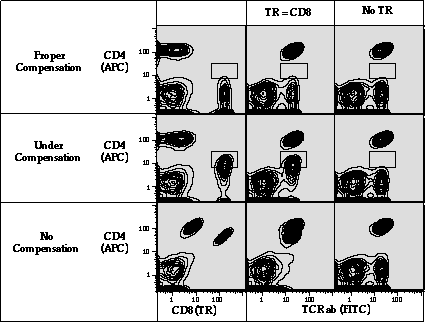
(Go back one page to 2-Color compensation: examples,
or back to the introduction)
This example is adapted from Kantor & Roederer, "FACS analysis
of leukocytes," in the Handbook of Experimental Immunology, 5th Ed
(1996), Herzenberg, Weir, Blackwell, and Herzenberg (eds).
An analysis of splenic T cells with different compensation values is presented
in the figure below. The cells were stained with three MAb reagents: 1)
FITC labeled anti-TCR, which identifies essentially all splenic T cells,
2) biotin-labeled anti-CD8, which is revealed with Texas Red-Avidin (TR-AV)
and identifies about half of the T cells and 3) allophycocyanin (APC)-labeled
CD4, which identifies the other half of splenic T cells. There are essentially
no T cells in the spleen which are double-positive for CD4 and CD8. TR and
APC are both excited with a dye laser (excitation 600 nm) and have significant
overlap of their emission spectra.

Legend: Spleen cells from a Balb/c mouse were stained with APC-anti
CD4, FITC-anti-TCRab. For the profiles in the left and center column, biotin-anti-CD8
was also included and revealed with TR-Avidin. Proper compensation values
are 24.9% for the TR signal in the APC channel and 8.2% for the APC reagent.
For the under-compensated profiles, both compensation values were reduced
by 20% , to 19.9% and 6.6% respectively.
Two populations of T cells can be readily identified even without compensation
(bottom left). However, the false impression is given that the "CD4
cells" express some CD8 and the "CD8 cells" express a substantial
amount of CD4. As indicated by the diagonal orientation of the contours,
the signal in the two channels is highly correlated: this is expected because
(in reality) only one reagent contributes to each population and the "spillover"
fluorescence (in the "wrong" channel) is proportional to the true
fluorescence (in the "right" channel). Note that the TR-reagent
makes a larger contribution to the APC channel than the APC-reagent makes
to the TR channel (24.9 vs 8.2%).
Proper compensation is when the median signal of a singly stained population
(e.g., APC only) equals the median signal of an unstained population in
the overlap channel (TR). This setup yields an accurate picture of the surface
antigen distribution. T cells appear positive for either CD4 or CD8, but
not both (top left). Modest errors in setting the compensation values can
affect the interpretation of the data. In the middle panel, both the APC
and TR signals are undercompensated by 20% of their proper values (19.9
and 6.6% respectively). This gives the false impression that the CD4 T cells
are dull for CD8 and that the CD8 T cells are dull for CD4. Most importantly,
this undercompensation cannot be deciphered from this single FACS plot.
The compensation is just sufficient so that the contours do not show the
diagonal characteristic of the uncompensated plots. Note that the situation
becomes especially difficult to unravel when novel populations are being
investigated and when the two markers appear on the same cells; for example,
CD4 and CD8 on cells in the thymus. (Similar problems can arise when compensation
is set too high).
Problems with compensation are often not apparent when only one of the compensation
channels is viewed. In the middle and right columns, FITC-labeled anti-TCR,
which is not involved in the TR/APC compensation, is presented on the abscissa.
In the uncompensated profile, there appear to be two populations of T cells,
one bright, and one intermediate, for CD4. This duller population does not
stain with CD4 at all, but is simply the CD8 T cells. Note that if the TR
reagent had been a little brighter, the contour plots would show a single
CD4 T cell population. When the TR reagents are eliminated (bottom right),
the CD8 positive T cells are readily apparent as the TCR+ and CD4- population.
With proper compensation, the correct FACS profiles are obtained in the
presence or absence of the TR reagent. With undercompensation, once again
it appears that there is a population of T cells which are dull for CD4.
Including stains with fewer reagents is an extremely effective way to build
a multi-parameter FACS analysis protocol and evaluate artifacts. As seen
in the example, the TCR-CD4 plots are all correct in the absence of the
CD8 stain in the TR channel, regardless of the compensation value used (since
compensating from a channel with no fluorescence has no effect). Compare
and contrast the CD4 vs. TCRab profile. The CD8 reagent is absent in the
right column. With proper compensation, both stains give the correct result.
With under-compensation, or even no compensation, the profile without the
TR stain still gives the correct result. There is simply no TR signal to
be detected in the APC channel. This example suggests an important point:
it is best to build 3 or 4 parameter analysis protocols by adding one component
at a time.
Finish off with errors introduced by compensation.